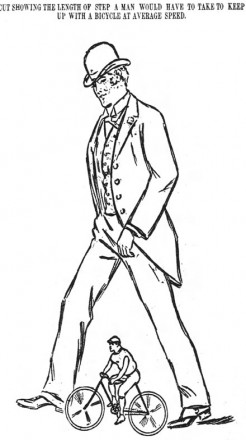The Constitution: Atlanta, GA – Sunday, April 19, 1896
Nearly Everybody, Young and Old, Rich and Poor, Is Riding Nowadays.
When Atlanta’s first big exposition was in progress fifteen years ago a spinster school teacher, tall and slender and elderly, was “seeing the sights” with her sister. She came from a little settlement hidden away in the mountains of Rabun county, and it was her first visit to a big city. The cotton exposition contained many marvels which excited her wonder, and she frequently expressed her surprise in the crude parlance of a mountaineer.
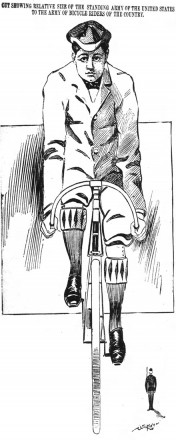 “Well, I’ll swow, Mandy,” she said on more than one occasion, “what will these city folks do next?”
“Well, I’ll swow, Mandy,” she said on more than one occasion, “what will these city folks do next?”
Her greatest surprise-perhaps it would be fair to say-her greatest shock, occurred on the last day of her visit. The high bicycle was a new thing in Georgia at that time and its appearance on the streets was watched with interest by everyone. To the school teacher it was more than interesting, it was phenomenal, and at the first sight of one she clutched her sister’s arm in wild alarm and told her to “look quick and see that wheel running away with a man.”
The good lady, if she is still alive, would see about 1,200 wheels “running away” with men and women, too, if she would pay Atlanta a visit today.
The growth of the bicycle “craze,” as some people insist on calling it, has been very healthy and fairly rapid in this city of late. From December 1st there have been nearly 500 new wheels sold in Atlanta. Of this number 400 are being ridden daily by Atlanta people. There are 1,200 wheels in daily use here, which is clear evidence that bicycling is beginning to be appreciated as a healthy and enjoyable sport.
Those who think that Atlanta is leading in this innovation, however, are mistaken. Atlanta is not so far behind other cities on the bicycle question as to be ashamed of her position, but she is by no means leading the van, not even in the south. Savannah, St. Augustine and New Orleans have become thoroughly imbued with the bicycle fever, and in proportion to population they are slightly ahead of Atlanta.
If Atlanta had as many bicycles in proportion to population as Washington, New York, Boston and Chicago there would be in the neighborhood of 10,000 wheels instead of 1,200.
A bicycle salesman, one who is thoroughly posted on the bicycle situation in every city in America, said yesterday that he believed the bicycle business in Atlanta was more promising today than ever.
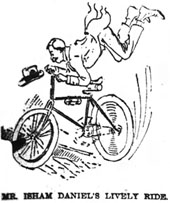 “The people here have just come to the full appreciation of the merits of the wheel,” he said, “and I confidently expect to see 2,000 wheels in this city at the close of the season where there are only 1,200 now. The people people are practically unanimous in indorsing the sport and society has stamped with its approval the debated question: “Shall women ride?”
“The people here have just come to the full appreciation of the merits of the wheel,” he said, “and I confidently expect to see 2,000 wheels in this city at the close of the season where there are only 1,200 now. The people people are practically unanimous in indorsing the sport and society has stamped with its approval the debated question: “Shall women ride?”
Good Roads for Bicyclists.
Peachtree street is the wheelman’s delight. Pryor street is satisfying to the most fastidious. Aside from these two thoroughfares Atlanta is deficient in bicycle paths, but the suburban roads afford excellent riding. Those who have ridden long enough to become inured to a good, long tour, find a spin out to Lithia Springs or Stone Mountain enjoyable. The roadways through and around Inman Park are good. The trip to Buckhead makes a pleasing run of fourteen miles. One of the favorite bicycle paths is along the old Peachtree road and great things are expected of the road to the barracks if the government will pass the appropriation for improving it.
At present there are no large bicycle clubs here. Small parties can be seen every morning and evening when the heat of the sun is not oppressive, spinning away to the suburbs. Tourist parties from northern and eastern cities often rent wheels for an afternoon to take a better look at the Gate City and its surroundings.
It is said that preliminary steps are being taken to organize a very large club of local wheelmen who will take regular tours every evening.
Scorching Habit Condemned.
The theory that every rose has its thorns applies with as much truth to bicycling here as elsewhere. The “Scorcher” is the bete noir of the beginner’s life. As Mr. B. F. Copeland, the manager of the riding school at the Gate City Guard’s armory said yesterday: “There is nothing which so retards the growth of bicycling in this city as scorching. It would not be a bad idea if the city council would pass an ordinance prohibiting great speed within the corporate limits.”
This has been done in nearly all of the larger cities. In New York the policemen who are stationed along th Boulevard are provided with bicycles for the purpose of arresting wheelmen who go faster than the law allows. The great bicycle path from Brooklyn to Coney Island, which is said to be the finest in the world, is always patrolled by policemen in knickerbockers, who can “scorch” most of the racers when it is necessary to make an arrest. In case they cannot catch a fast racer their shrill whistle causes the policeman ahead of him to mount his wheel and when Mr. Scorcher has distanced his first follower he finds himself in the clutches of the second or third, as the case may be. It is impossible to escape and yet is surprising how many bold wheelmen will attempt it. There are at least a dozen such captures on the Brooklyn bicycle path every Sunday.
Atlanta Policemen on Bicycles.
The ladies of Atlanta are the great enemies of the scorchers. They have begun a crusade to have the habit stopped and they are firm in their determination. The chances for a bicycle squad for the Atlanta police force are good. In case the city council passes an ordinance restricting the speed on Peachtree street it will be necessary to mount the policemen who patrol that thoroughfare on bicycles in order to prevent violations of the ordinance.
Where Beginners Learn To Ride.
One of the most interesting sights to be seen in Atlanta at this season is the classes of beginners at the Columbia Bicycle academy in the Gate City Guard’s armory. There is much to arouse the mirth of the visitors, but there is little of humor to the novices themselves except when they are resting and their friends are “going through the mill.”
The beginner as a rule has the look of a wild horse who suddenly sees the approach of a locomotive for the first time. There is a glare of fright and curiosity in the eyes, which is in strange contrast with the clinched teeth and the expression of “do or die” depicted in the tightly closed mouth. The best time to see the show is from 8 to 10 o’clock at night, when the business men are taking their first lessons. Awkwardness, timidity, assumed boldness, despair and uncertain hope are illustrated as well as they could possibly be by the actions and expressions of the “first nighters.” It must be seen to be appreciated. No description can give a fair idea./
The management of the school says that the ladies learn very much more easily than the men. They are less awkward. The ladies’ classes are from 8 a. m. to 1 p. m. and 2 p. m. to 6 p. m. The ladies are also given what are known as direct lessons. When they reach a certain point in advancement and gain a little confidence they are put in charge of an instructor and taught on the street. There are many expert graduates of the school among the lady riders of the city.
Major Fitten a Graceful Wheelman.
Major John A. Fitten is one of the city’s graceful wheelmen. This is true despite the major’s 265 pounds. He flits about with ease, notwithstanding that he is a heavy weight.
He learned at the wheeling school in the Grand. It took him some time, but he learned thoroughly. His school days were attended with many hard knocks and falls, but he pulled through without any broken limbs. He is now having a huge wheel of stout frame specially manufactured for himself and in a short time he will be spinning over the city’s by-paths on his trusty charger.
Major Fitten took his lessons at the school at the early hour of 6 o’clock in the morning. Rosy from a good night’s sleep he would hie himself to the school. He would mount the wheel with the courage of a Spartan and proceed to land himself violently upon the floor some twenty feet from the starting point. Nothing discouraged, he would spring to his feet nimbly, scurry upon his vehicle and hurry away again.
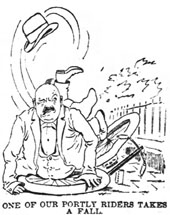 He had a great rival in the person of Colonel Thornton, who also tips the scales at 265 pounds. They took lessons together and had many an exciting encounter. Their antics were the talk of the school and every pupil felt a deep personal interest in the outcome of their studies. They both graduated about the same time are now vieing with each other in the ease and grace with which they spin across the country.
He had a great rival in the person of Colonel Thornton, who also tips the scales at 265 pounds. They took lessons together and had many an exciting encounter. Their antics were the talk of the school and every pupil felt a deep personal interest in the outcome of their studies. They both graduated about the same time are now vieing with each other in the ease and grace with which they spin across the country.
The teacher, Mr. Copeland, also taught Speaker Tom Reed the mysteries of the wheel. This occurred last spring and it was not an easy task. The speaker weighs 295 pounds and he is not unlike Major Fitten in physical build. “Major Fitten is much more more agile,” said Mr. Copeland yesterday, “and handles himself much better. He learned much faster.”
Smashes a Wheel.
Jim McKeldin is one of the city’s enthusiasts. He has been riding a beautiful $125 wheel of which he is immensely proud. He was out on the asphalt with a party a few nights ago and met Major Fitten.
“You don’t know the first thing about riding,” said the major scornfully.
“I don’t, eh?” said Mr. McKeldin; “suppose you try it.” He hopped off his wheel. “Here, get up, major, and give us a lesson,” he said.
The major held back modestly. “Oh come on,” said Mr. McKeldin.
“Well, here goes,” said the major, and he made a leap for the saddle. The wheel shot gracefully forward. The pedals responded easily to the major’s expert touch. He went sailing down the asphalt as graceful as a fairy.
There was a sudden crash, and looking, Mr. McKeldin saw his wheel sink into utter ruin and collapse beneath the major’s portly form. It was not an ordinary collapse. It was an extraordinary one. The wheel did not simply break in part. It broke all to pieces, into hundreds of pieces. The seat was mashed as flat as one of Aunt Jemima’s pancakes, and the wires of the wheels were twisted into a million shapes. It was hard to tell whether it was the remains of a bicycle or a dynamo. There was no semblance of a wheel left.
Isham Daniel’s Ride.
Although Mr. Isham Daniel has laid strict injunction upon his companion not to repeat the story, it has gained general currency and I will repeat it here-the story of Isham Daniel’s swift and disastrous ride.
He took to the wheel gingerly. He did not enter into it with that conquer in-a-minute-or-die spirit. He was patient. He lacked confidence, and he wanted room. He did not like to ride on a street on which there were any other moving objects, and he always avoided cars. Cars were his pet fear.
He went out with Jim McKeldin the other afternoon late. He paced along carefully until Wilson avenue was reached. It’s a fine drop for the wheelmen down Wilson avenue to the expostion gate.
“Go it, Isham, I’ll follow,” said McKeldin.
Mr. Daniel moved forward slowly at first, his wheel gaining in celerity as he went. Presently it was moving at furious speed and the rider found his feet off the pedals and himself unable to regain control of the mad steed. At this juncture a car loomed into view, coming toward him in front. He knew for a certainty that collision with that car was inevitable. The thirty feet of space that he had on his side of the track was far too narrow to allow him to pass in safety. There was but one thing to do; he would dash into the sidewalk.
It was a startling spectacle that Mr. McKeldin looked down upon. He saw his comrade swerve violently to the right and with the force of a steam engine dash into the high curbing. The wheel stopped with a crash and was dashed to pieces, and the force of the collision lifted Mr. Daniel from his seat and planted him over in the vacant lot. He got up unhurt, glad to sacrifice a wheel as the price of his own life.
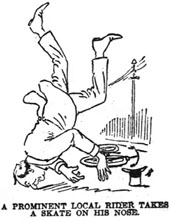
And There Are Others.
Mr. Thomas C. Erwin is also a victim of the freaks of the wheel. He was hurled from his, near Fort McPherson, last Sunday, and skated along the road on his face for a considerable distance. The experience was very damaging to the smooth contour of his face.
And there are others who are wearing bandages, poultices and plaster casts. The percentage of accidents is naturally high, considering the large number or riders there are in Atlanta. None of the sufferers from the wheel have given up, however. They are waiting to get well, when they will ride again.
